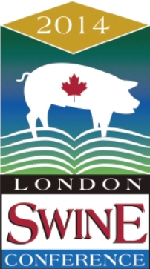



Lessons Learned from PEDv
Doug MacDougald of the South West Ontario Veterinary Services/Ontario Swine Health Advisory Board presented an update on porcine epidemic diarrhoea virus (PEDV) in Canada to the 2014 London Swine Conference in March 2014.
What Do We Now Know about PED in Ontario?
Clinical cases
As of 26 February, 23 pig sites have been diagnosed as PEDV positive. Nineteen of these sites are sow sites and represent approximately 16,000 sows or five per cent of the Ontario sow herd. Of these 23 sites, 17 have PEDV-contaminated feed as the common risk factor, linked to one US origin porcine plasma shipment to Ontario.
CFIA bioassay has confirmed that this porcine plasma product was PCR-positive for PEDV and on 18 February, CFIA issued a statement indicating: “Testing with a swine bioassay has determined that the plasma ingredient contains PED virus capable of causing disease in pigs.”
The information from the balance of cases points to biosecurity gaps involving farm, transport and other. Pig movement from these sites will result in a significant increase in contaminated sites in the short-term.
PED is an emerging disease that veterinarians must report to the Ontario Ministry of Agriculture and Food (OMAF) under the Animal Health Act. To date, the rate of new cases remains very low. This is different from what was observed in the US. OMAF and private veterinarians, Ontario Pork and many individuals in the swine sector are working hard to keep it that way.
Working with their veterinarians, the original case farms continue to successfully manage this serious disease. Some farms are again farrowing healthy piglets and elimination plans are already being put into place on some farms.
Now that PED has infected a number of sites in Ontario, continued efforts around biosecurity and extra vigilance is required by all sectors of our industry to control and contain the virus and work to protect our sow herd base.
Reports on new clinical cases can be seen at www.ontario.ca/swine.
Surveillance
Processors
The best surveillance data to date comes from the major processors. Their help is greatly appreciated. This system is the result of work by OMAF, private veterinarians and our packers that market about 85 per cent of Ontario hogs each week.
To date, only 5 per cent of the 721 trailers tested have been positive for PED virus, although positives continue to be detected on a regular basis. All Ontario trailers monitored that delivered market hogs to Quebec have been negative.
Positive trailer results could occur as a result of cross-contamination, hogs from already known positive farms, and other unconfirmed farms with mild PED infections. So far, trace-backs on these positive trailers have not uncovered any new serious PED virus infections on farms.
Transport
Over the course of the past few months, 18 transport companies and associated wash bays have been audited by swine veterinarians, focusing on high risk and/or high volume companies.
To date, 274 environmental samples have been taken from trailers and facilities with 18 positive tests or just under seven per cent testing positive for PEDV. A number of these positive tests were taken from trailers that had transported PEDV-positive pigs and so these results were expected. In these cases, wash and re-test confirmed negative status of the trailers. The transport industry has been highly cooperative and is making excellent efforts to reduce the risks of PEDV transmission.
The Lucan truck was has been identified as resource to assist in the management of trailers with high risk of contamination with PEDV.
Primary targeted trucks for this wash:
- Cull transport trucks returning from the US.
- Dedicated trailers that will transport cull animals from Talbotville to Wyoming.
- Trailers bringing cull animals from Quebec to Wyoming.
- Any positive or presumed positive truck that does not have a satisfactory wash solution.
Assembly
The three major assembly yards in Ontario have been working in close cooperation with the industry to reduce PEDV transmission risks and in fact had begun this work well before PED was diagnosed in Ontario. Environmental surveillance has confirmed that the Zantingh Direct Wyoming site is PEDV-positive.
Zantingh Direct has made significant effort in the development of biosecurity enhancements to reduce the risk of PEDV transmission. These efforts have included the development of a new assembly facility with controls for incoming and outgoing truck traffic as well as staff and visitor foot traffic. As well, a transfer station format has been developed to reduce risks associated with the Wyoming site.
The remaining two assembly sites have also implemented risk reduction strategies where required. All of these industry partners are continuing to work with swine veterinarians to assess and reduce risks.
Summary and Lessons Learned
There is every hope we can keep the impact from PED at a low level in Ontario with continued vigilance and strict biosecurity, particularly at the farm gate.
We must focus on containment in the remaining cold months so that we can get into the spring or early summer where this virus will not be nearly as easily transmitted.
OSHAB/Ontario Pork investigation of high-risk trucking events and reduction of risk from October to January was invaluable in being better prepared to respond to PED in Ontario.
Advance preparation of who the response team would be and what they would do was also invaluable. The public/private partnership of the response team made up of OMAF, Ontario Pork, OSHAB, OASV, AHL and practising veterinarians was quite effective.
Producers and service companies were transparent with information, supportive of containment and control measures and invaluable in assisting with investigation. Without the openness of industry and producers, we would not have been successful.
Communication to industry was not timely, accurate or open. The broader industry was operating in a vacuum of rumours and misinformation. In future, there needs to be a clear communication plan to keep industry in the loop as to what we know, what are we investigating, timing of results, update on what we know and what we are planning.
Resources on PED prevention and management are available from:
Reference
MacDougald D. 2014. Lessons learned from PEDv. Proceedings of the London Swine Conference. London, Ontario, Canada. 26 to 27 March 2014. p19-21.
Further Reading
You can view other papers presented at the 2014 London Swine conference by clicking here.
September 2014








